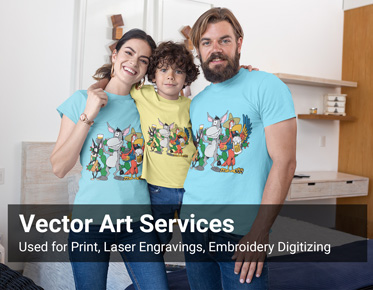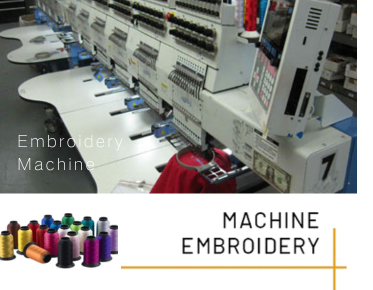How Do I Clean a Screen Printing Screen?/Eagle Digitizing
How Do I Clean a Screen Printing Screen?
Regarding screen printing, keeping your screens impeccably clean is not just a good practice—it's a necessity. Properly maintaining your screens ensures crisp, clear prints and extends the lifespan of your equipment. Let's dive into why cleaning your screen printing screens is crucial and explore the entire cleaning process. If this post piqued your curiosity and you wish to learn more about vector conversion, feel free to reach out to us.
Importance of Cleaning Screen Printing Screens
Cleaning your screen printing screens is paramount to producing high-quality prints. Residual ink, emulsion, and debris can compromise the sharpness of your designs, leading to subpar prints that tarnish your reputation. Moreover, a well-maintained screen enhances ink flow and adhesion, making each print as vibrant and precise as intended.
Overview of the Cleaning Process
The cleaning process for screen printing screens involves several steps: pre-cleaning inspection, degreasing, ink and emulsion removal, dehazing, and a final rinse and dry. Each stage is vital to ensuring your screen is free from contaminants and ready for the next use. This methodical approach guarantees a clean, reusable screen that performs consistently.
Understanding Your Screen Printing Screen
Types of Screen Printing Screens (Mesh Count, Material)
Screen printing screens come in various mesh counts and materials, each suited for different applications. Mesh count refers to the number of threads per inch; a higher mesh count offers finer detail but less ink flow, while a lower mesh count allows for thicker ink deposits. Materials range from polyester, known for its durability, to nylon, which offers excellent elasticity. Choosing the right type depends on your specific printing needs.
Components of a Screen Printing Screen (Frame, Mesh, Emulsion)
A screen printing screen comprises three main components: the frame, the mesh, and the emulsion. The frame, typically made of aluminum or wood, provides structural support. The mesh, stretched tightly across the frame, serves as the stencil surface. Emulsion, a light-sensitive liquid, coats the mesh and hardens to create the stencil design. Each component is vital to the printing process.
Preparing for Cleaning
Gathering Necessary Supplies
Before starting the cleaning process, gather all necessary supplies to ensure a seamless operation. The right tools and products make the task more efficient and effective.
Cleaning Solutions (Degreaser, Emulsion Remover)
You'll need a high-quality degreaser to remove oils and contaminants from the screen, and an emulsion remover to break down the hardened emulsion. These solutions are specifically formulated for screen printing and ensure thorough cleaning without damaging the screen.
Tools (Brushes, Scrub Pads)
Invest in durable brushes and scrub pads designed for screen printing. Soft bristle brushes are ideal for delicate screens, while firmer scrub pads can tackle more stubborn residues. These tools help you clean every nook and cranny of the screen.
Safety Gear (Gloves, Eye Protection)
Protective gear is essential. Wear gloves to prevent skin irritation from cleaning chemicals and eye protection to guard against splashes. Safety should always be a priority during the cleaning process.
Setting Up Your Work Area
A well-organized work area enhances efficiency. Ensure you have ample space to maneuver and that all cleaning supplies are within reach. A clean, well-lit area minimizes the risk of accidents and allows for a more thorough cleaning job.
Step-by-Step Cleaning Process
Pre-Cleaning Inspection
Checking for Ink Residue
Before you begin, inspect the screen for ink residue. Dried ink can be challenging to remove and may require extra attention. Look for any stubborn spots that need special care.
Assessing the Condition of Emulsion
Examine the emulsion layer for signs of wear or damage. Cracks or peeling indicate the need for reapplication. Identifying these issues early prevents print defects.
Degreasing the Screen
Importance of Degreasing
Degreasing removes oils and contaminants that can interfere with the emulsion application. A clean surface ensures better emulsion adhesion, resulting in sharper prints.
Choosing the Right Degreaser
Select a degreaser specifically formulated for screen printing. These products are designed to remove stubborn oils without harming the screen mesh.
Applying the Degreaser
Apply the degreaser evenly across the screen. Use a brush to scrub the surface gently, ensuring all contaminants are removed. Rinse thoroughly with water to remove any residue.
Removing Ink and Emulsion
Using Emulsion Remover
Emulsion remover is essential for breaking down the hardened emulsion layer. Apply it generously and allow it to sit for a few minutes to penetrate the emulsion.
Techniques for Effective Ink Removal
Use a scrub pad to work the remover into the emulsion, focusing on stubborn areas. Rinse with water and repeat if necessary until all emulsion is gone.
Scrubbing and Rinsing
Scrub the screen with a soft brush to remove any remaining ink and emulsion particles. Rinse thoroughly to ensure all cleaning agents are washed away.
Dehazing the Screen
Purpose of Dehazing
Dehazing removes any residual ghost images or stains left by previous prints. This step is crucial for maintaining screen clarity and ensuring clean prints.
Methods for Dehazing
Apply a dehazing solution to the screen and let it sit for the recommended time. Scrub the screen with a brush, paying attention to stained areas, and rinse thoroughly.
Ensuring Screen Clarity
After dehazing, inspect the screen for any remaining stains or residues. Repeat the dehazing process if necessary to achieve optimal clarity.
Final Rinse and Drying
Thorough Rinsing Process
Rinse the screen thoroughly with water to remove all cleaning agents. Ensure no residues remain, as they can affect future prints.
Drying Methods (Air Drying vs. Drying Cabinet)
Dry the screen completely before reuse. Air drying is effective but can take time, while a drying cabinet speeds up the process. Ensure the screen is completely dry to prevent issues with emulsion adhesion.
Maintaining Your Screen Printing Screen
Daily Maintenance Tips
Cleaning After Each Use
Clean your screens immediately after each use to prevent ink from drying and becoming difficult to remove. This routine maintenance keeps your screens in top condition.
Storing Screens Properly
Store your screens in a dry, cool place to prevent damage. Use screen racks to keep them upright and avoid stacking, which can cause warping.
Regular Deep Cleaning Schedule
Frequency of Deep Cleans
Schedule regular deep cleans based on usage. Heavy use may require weekly deep cleans, while occasional use may only need monthly maintenance.
Preventive Maintenance Practices
Implement preventive practices such as regular inspections and immediate repairs to extend the lifespan of your screens and ensure consistent print quality.
Troubleshooting Common Issues
Screen Stains and Discoloration
Causes and Solutions
Stains can result from residual ink, improper cleaning, or using the wrong cleaning agents. Use dehazing solutions and thorough cleaning techniques to address these issues.
Persistent Ink Residue
Effective Removal Techniques
For stubborn ink residue, use specialized cleaners and scrub pads. Repeated applications and scrubbing may be necessary for complete removal.
Emulsion Issues
Repairing and Reapplying Emulsion
Damaged emulsion can cause print defects. Eradicate the old emulsion and reapply a fresh coat, ensuring an even and smooth application.
Environmental Considerations
Proper Disposal of Cleaning Solutions
Dispose of cleaning solutions responsibly. Adhere to local regulations for hazardous waste disposal to reduce environmental impact.
Eco-Friendly Alternatives
Consider eco-friendly cleaning solutions that are biodegradable and less harmful to the environment. These alternatives can be effective while reducing your ecological footprint.
Importance of Regular Screen Maintenance
Regular maintenance of your screen printing screens is essential for several key reasons, all of which contribute to the overall success and efficiency of your screen printing operations.
High-Quality Prints
Consistent maintenance ensures that your screens are always in top condition, which is crucial for producing high-quality prints. Clean screens provide a smooth and even surface for ink transfer, resulting in sharp and vibrant images. Any residue or contamination on the screen can lead to imperfections, such as blurred lines or uneven ink distribution, which can compromise the quality of your prints.
Prolonged Equipment Lifespan
Proper care and regular maintenance of your screens significantly extend the lifespan of your screen printing equipment. Screens that are well-maintained are less likely to suffer from wear and tear, reducing the need for frequent replacements. This not only saves you money in the long run but also ensures that your equipment remains reliable and efficient over time.
Prevention of Common Issues
Regular cleaning practices help prevent a range of common screen printing issues:
● Ghosting: Residual images from previous prints can appear as faint, unwanted marks on new prints. Regular dehazing and thorough cleaning eliminate these ghost images.
● Clogging: Ink residues and other contaminants can clog the screen mesh, leading to poor ink flow and inconsistent prints. Regular degreasing and ink removal prevent these clogs and ensure smooth ink transfer.
● Poor Ink Transfer: Clean screens ensure that ink adheres properly and transfers evenly to the substrate. This results in clear and precise prints, enhancing the overall print quality.
Reliable Performance
Maintaining your screens ensures reliable performance during printing. Clean screens are less prone to unexpected issues, such as ink blockages or screen damage, which can disrupt your workflow and cause delays. Consistency in maintenance means that your screens are always ready for use, allowing for uninterrupted production and increased efficiency.
Cost Savings
By keeping your screens in optimal condition, you reduce the likelihood of costly downtime and equipment replacements. Regular maintenance helps detect and resolve potential issues before they escalate into major problems, saving you time and money on repairs and replacements. Additionally, well-maintained screens require fewer replacements, reducing your overall operational costs.
Overall Success
Ultimately, regular maintenance of your screen printing screens contributes to the overall success of your screen printing projects. High-quality prints, reliable performance, and cost savings all play a role in ensuring that your screen printing business runs smoothly and efficiently. By prioritizing maintenance, you uphold your commitment to excellence and deliver consistently superior products to your clients. For additional support, Eagle Digitizing offers vector graphic conversion services to complement your screen printing needs.
In summary, the importance of regular screen maintenance cannot be overstated. It is a critical practice that enhances print quality, extends equipment lifespan, prevents common issues, ensures reliable performance, and saves costs. By maintaining your screens and utilizing professional services like those from Eagle Digitizing, you set the foundation for successful and efficient screen printing operations.



